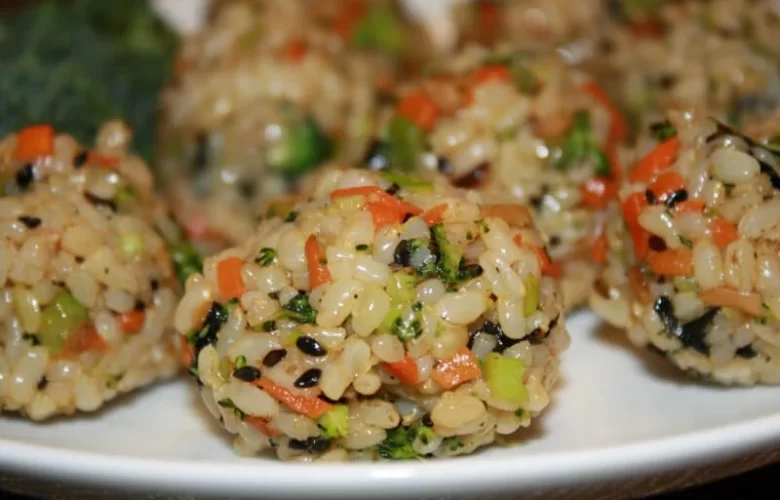Lee Minho, with those long eyelashes, moves around in the kitchen making Bibimbap for his yeoja-chingu with the leftovers in their fridge, and your mouth starts watering! After all, who wouldn’t prefer a dump of leftover rice blended with an assortment of veggies and dashed with some gochujang and sesame oil?? It is no secret that Korean magic has spilled over globally, introducing you to more than the traditional convenience store Korean ramyeon. There are a plethora of Korean vegetarian dishes available at your disposal. You don’t need to fly down to Seoul to enjoy those lip-smacking delicacies. Get the ingredients (readily available at the stores or alternatives) and ruse them up for dinner.
In this post, we will give you insights into a handful of these vegetarian dishes for the ones who would steer clear of the ‘red meat’ and ‘seafood’ – a staple of the Korean diet. Let us show you the specifics –
Table of Contents
Korean vegetarian dishes you cannot miss
Let us take a look at some of the samplings –
Please note: The measurements are as per the US standards.
If you are a fan of noodles (Gugsu)
The land is not famous only for the instant ramyeon. There is more than a single variety for you to check out –
1. Traditional Japchae (Korean glass noodles)
Yes, you have seen so many heroines simply requesting their dear heroes to get Japchae takeout. One of the famed Korean vegetarian dishes – this is how you make it –
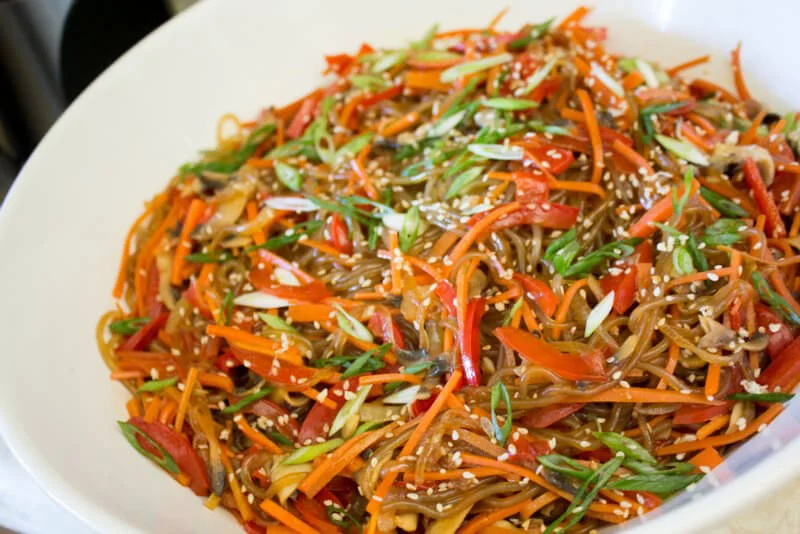
What you will need?
. The standard cellophane noodles, and chopped cabbage – 2 cups each
. Julienne carrots – 1 cup
. Spring onion – 5 leaves
. Soy sauce – 6 tablespoons
. Garlic cloves – 4
. Red onion – 1/2 cup
. Vegetable oil – 2 tablespoons
. Sesame oil – 1 tablespoon ‘
. Sesame seed – 1 teaspoon
. Shitake mushroom – 1 cup
How to make it?
. Start by blending the sesame oil, seed and soy sauce. Leave it aside for later usage.
. Boil water in a pot and add the noodles to it. Let it simmer for 5 minutes. Once the noodles turn soft, you can drain the water and leave the noodles to cool down.
. Take a frying pan, and heat vegetable oil on medium heat. Once over, add the garlic and onion and cook it for 3-4 minutes (till the onions turn brownish).
. After this one by one add the ingredients and keep cooking. Start by adding the shitake mushrooms, and cook them till they are brown. Then add the carrots, spring onions, and chopped cabbage.
. Once you have cooked all the ingredients, add the noodles and mix them well with the prior ingredients. Add the soy sauce kept aside. Give it a stir and cook it for another 4-5 minutes.
. Garnish with the sesame seeds and serve hot!
2. Bibimmyeon
This technically is listed under Korean vegetarian dishes but even non-vegetarians relish this dish as well! After all, it’s not every day that you get to garnish noodles with a hard-boiled egg!
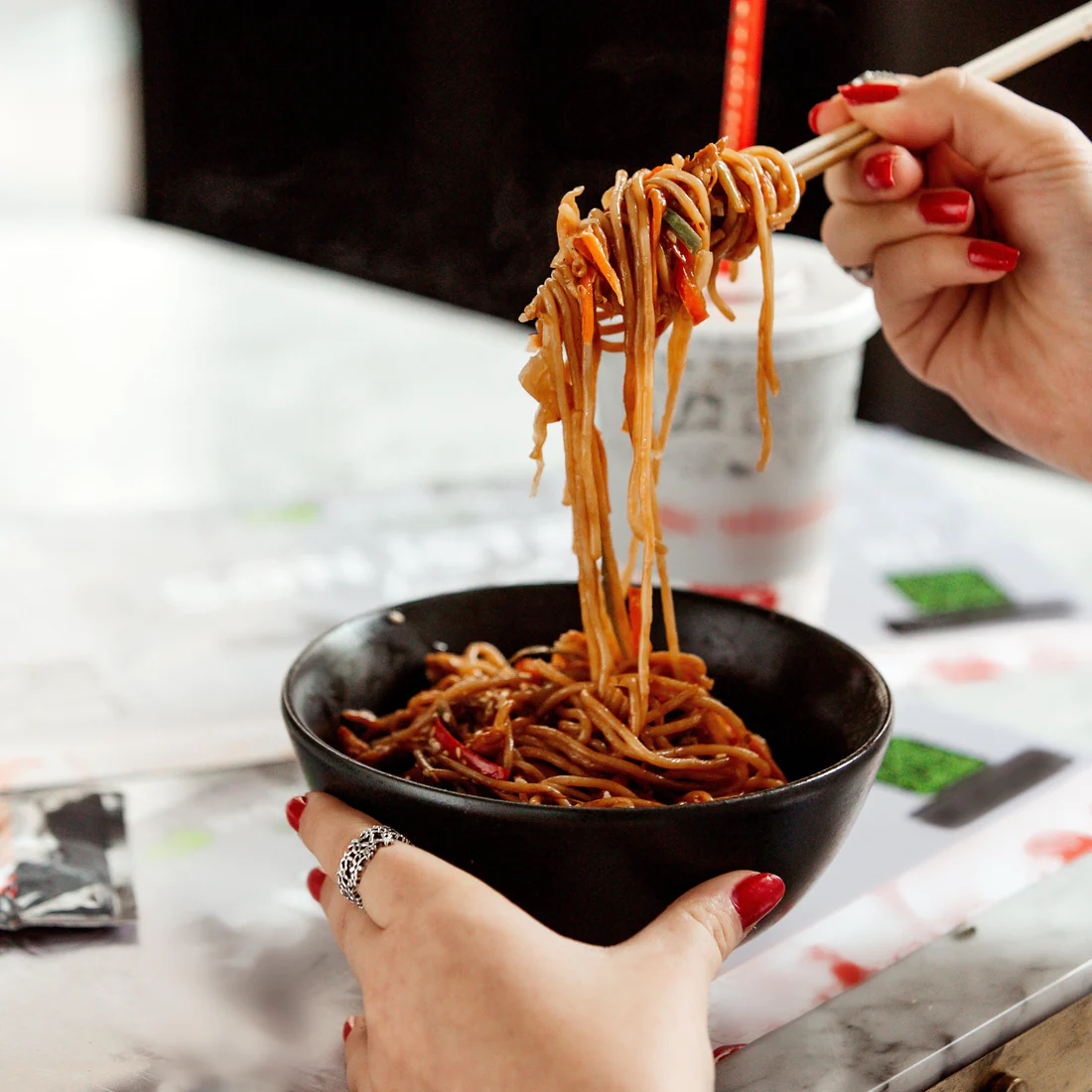
What you will need?
. Thin wheat noodles – 1 ½ cup
. Gochujang and Kimchi liquid – 2 tablespoons each
. Rice wine vinegar – 1 tablespoon
. Sesame seeds and oil – 1 tablespoon each
. Soy sauce – 2 teaspoons
. Gochugaru (Korean chili flakes) – 1/2 tablespoon
. Minced garlic cloves – 2
. Sugar – 1/2 tablespoon
. Salt and pepper to taste
. Thinly sliced cucumber (1)/Diced kimchi (1/4 cup)/ sesame seeds – for garnishing
. Hard-boiled eggs – 2 (optional – for garnishing)
How to make it?
. Boil a pot of salt water and cook the noodles as per instructions. Once the noodles are cooked, drain the water and let it rest for 30-60 minutes.
. Blend a couple of the ingredients to prep the base. Combine the kimchi brine, vinegar, sesame seed and oil, 1/2 teaspoon of salt and pepper, sugar, soya sauce, gochujang, garlic, and gochugaru. Whisk these ingredients well to create a thick paste.
. Take the noodles and coat them with this paste. Season with kimchi, cucumber slices, and sesame seeds.
The Korean rice dishes are nothing less (Ssal)
Korean rice dishes are always a treat. Whether it is the Kongnamul Bap, or Tteokbokki, or even Injeolmi – they have a special place when one talks of Korean vegetarian dishes. Here are 2 of the often-opted ones –
3. Kimchi Fried Rice
Packed with the reckoned kimchi, this fried rice is a treat to your tongue.
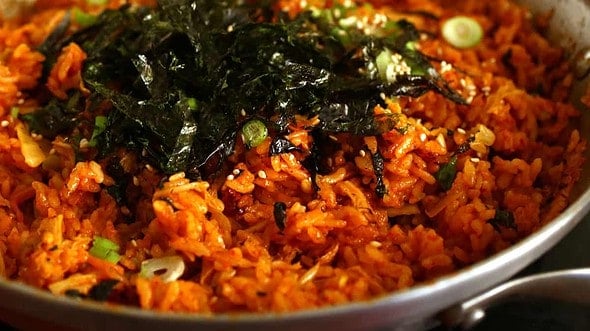
What you will need?
. Japanese rice/short grain rice (cooked) – 3 cups
. Soya sauce and cooking oil (your choice) – 2 tablespoons each
. Sesame seed (toasted for garnishing) and oil – 1 tablespoon each
. Kimchi and medium-sized onion (chopped) – 1 cup
. Korean gochujang paste (red chilli flake paste, you can use sriracha sauce as an alternative) – 1 teaspoon
. Bean sprouts – 1 1/2 cups
. Garlic cloves – 3
. Kimchi juice – 1/4 cup
. Egg – sunny side up (optional) – 2
How to make it?
. Start by adding the cooking oil and put it on medium heat. After 3-4 minutes, when the oil has heated up, add the onion and stir it so that it becomes light brown. After that, add the garlic cloves to it and cook it for close to 1 minute.
. To this concoction, you will have to add the kimchi and cook it for another 3-4 minutes. Once that is done, add the bean sprouts and continue with the cooking for another 2-3 minutes.
. Once your spicy concoction is ready, you will have to add the rice to this and stir for a while. Then in quick succession – add the kimchi juice, soya sauce, gochujang paste and sesame oil. Blend this well with the rice for 5 minutes.
. While serving, you may add the egg or not – depending on your choice.
4. Braised gochujang tofu (Dubu Jorim)
Packed with flavour, this is a dish that is best enjoyed when concocted with rice.
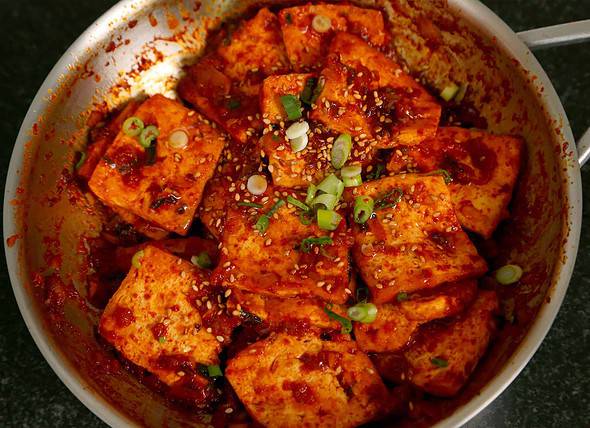
What you will need?
. Tofu (either cut into rectangular pieces – 8 or diced into small pieces) – 3 cups
. Water and soya sauce – 3 tablespoons each
. Sesame oil – 2 tablespoons each
. Minced garlic and gochujang paste – 1 tablespoon each
. Spring onion (sliced) – 1
. Sesame seeds (toasted) and sugar – 1 teaspoon each
How to make it?
. Ensure that the tofu is completely dried and does not release excess water.
. Take a bowl and add – soy sauce, sugar, garlic, gochujang, water and half the sesame oil. Whisk it well to make a thick concoction.
. Now take a frying pan and heat the leftover sesame oil on a high flame. Once it is hot, add the tofu to it and fry it till it becomes golden brown. Flip it and fry the other side as well.
. After your tofu has gained the brown shade add the whisked concoction you have made to it. Let it bubble and settle down. Cook it for 5 minutes.
. Lastly, assuming your tofu is cooked – take a bowl of cooked rice, and add this tofu preparation to it. Sprinkle sesame seeds and spring onion to complete the meal.
Those looking to twist their rice can surely prep these Korean versions of the dish.
Time for some side dishes (Banchan)
Korean vegetarian dishes that make up for an accessory dish are in huge demand. But, if you are in the mood for throwing in some random ingredients and cooking up a storm, these standalone dishes are your options to choose from –
5. Korean-style pumpkin wedges
Perfect as a finger snack, this is one of those Korean vegetarian dishes that fits every occasion, from casual to a formal dinner set-up.
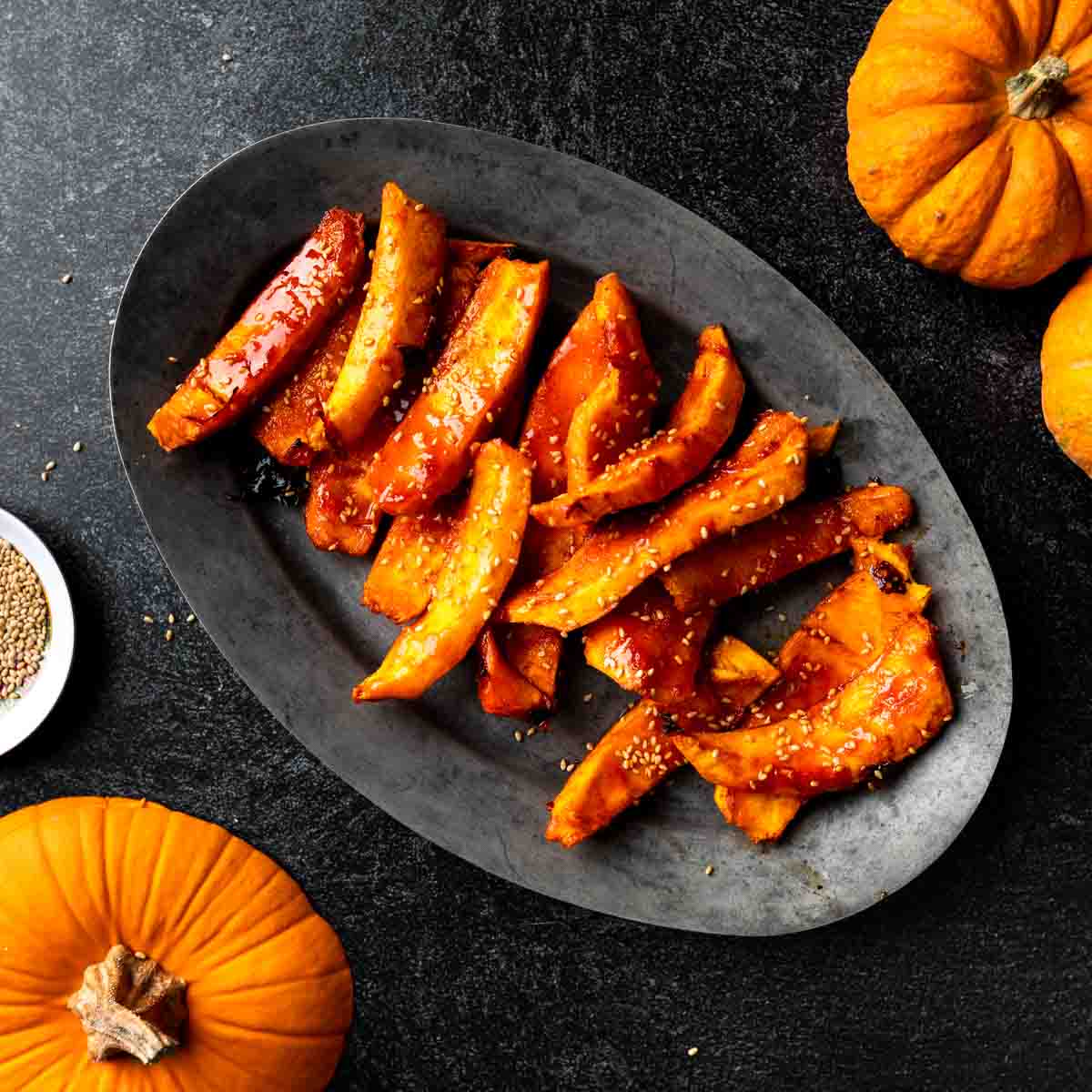
What you will need?
. Sugar pumpkin (peeled and seeded – sliced in 1 inch like wedge form)
. Gochujang sauce and melted butter – 2 tablespoons each
. Maple syrup (pure) – 1/4 cup
. Kosher salt – 1 teaspoon (if you use table salt, reduce the quantity by half)
. Sesame seeds – 1 tablespoon – (toasted) – you will need it for garnishing.
. Clove – a pinch
. Garlic powder – 1/4 teaspoon
How to make it?
. Start by preheating the oven to 425 F/220C and prep a sheet tray
. Take a bowl and mix the other ingredients in a way to whisk up a batter. After that, you will have to take the pumpkin wedges and toss them in this blend for a minimum of 4-5 minutes. Ensure that all sides of the wedges are covered.
. Place the wedges on the parchment sheet in a manner so that the cut-out sides are placed downwards. Bake for 10 minutes. Once that is over, flip the wedges and bake the other side as well.
. After you are done baking both sides, bring the wedges out, and glaze them again with the whisked concoction. Bake them for another 5 minutes.
. To caramelize the pumpkin, turn the broiler on and boil for a maximum of 2 minutes. Serve hot by sprinkling sesame seeds on top.
6. Hobakjeon (Korean pancake)
This is what you may call Korean zucchini pancakes. Savoury and filling, when in a rush, or looking for something simple – go for this!
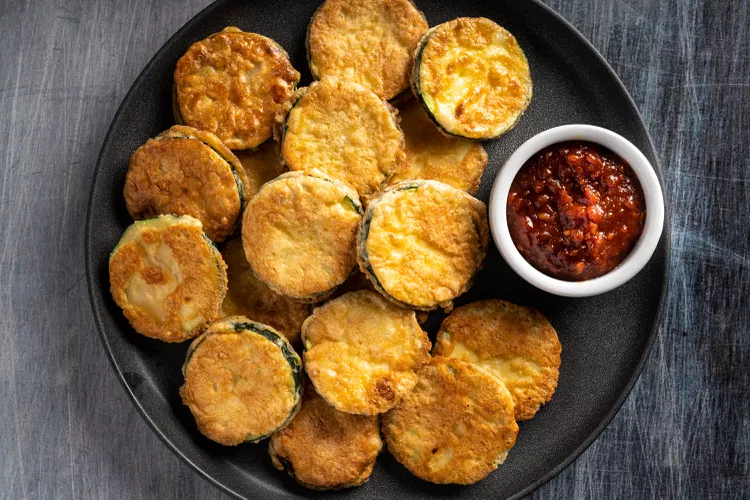
What you will need?
For the pancake –
. Julienne cut zucchini (chopped like matchsticks) – 2 cups
. Cassava flour – 1/2 cup
. Cooking oil (avocado oil/ olive oil) – 2 tablespoons
. Sea salt – 1 teaspoon
. Egg – 1 (if not, then replace with mashed bananas/silken tofu/usual store-bought egg replacement)
For the dipping sauce –
. Vinegar (apple cider vinegar/coconut vinegar) and coconut aminos – 2 tablespoons each
. Water – 1 tablespoon
. Green onion (chopped) – 1
. Gochugaru (Korean red pepper flakes)/ Honey/ sesame oil – 1/2 teaspoons each
How to make it?
. For starters, whisk up the sauce and keep it aside. To do that, simply blend all the ingredients, and whisk them up in a thick concoction.
. For the pancakes, start by combining the zucchini with the sea salt and toss it together for 20 minutes. You will see that this zucchini will discharge water. Take a cheesecloth to swing out the excess water and store it aside.
. After that, take that cooked zucchini, the leftover water, egg (or alternative), and the cassava flour – and blend them well for a thick consistent batter. If required, add a teaspoon of plain water to it.
. Heat the cooking oil of your choice for 5 minutes on medium heat. Once it has heated up, you may either add the batter in small pieces or as a whole. Cook it for 3-4 minutes on one side and then flip.
. Serve hot with the dipping sauce!
These are some of the handy veg recipes that you may try out as per your choice.
A quick piece of info
For the unversed, there is another reason why Korean vegetarian dishes have taken the world by storm. These dishes are curated in a way that balances the ‘yin-yang’ concept, which thereby improves digestive health. The well-thought-out combo of vegetables provides your body with the much-required fiber without adding the ‘unhealthy fat’ content to it.
What’s more? You can find most of the ingredients at any convenience store. If not, you can always use its widely available alternatives. There won’t be much of a difference in terms of the taste.
Parting thoughts
With the K-aura engulfing much of our lives, it is no secret that you want to rack up and gobble down some Korean vegetarian dishes. Having said so, these dishes are easy to curate, extremely nutritious, mostly made from leftover samples of food, and can be made in batches for later consumption. Once you make them, just keep having them as and when you like (you can freeze the food for a week at least). Oh! Did we miss it? Don’t forget to tune in to some classic Korean dramas online as you dig into your late-night mandu!
Monalisa Mukherjee is a content writer, copywriter and editor with 4 years of experience. She has written for websites like Biography Talk, The Rich Net Worth, Contour Cafe, He And She Fitness and Fiction Pad. She is currently associated with a noted Digital Marketing Agency and specialises in writing press release, guest posts, articles on travel, entertainment, food recipes, celebs, lifestyle, tech, health, and fashion.

